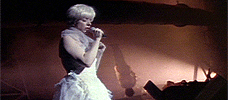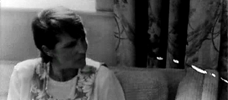Reviews
The Dream of the Brokenhearted
David Lynch
USA, 1990
Credits
Review by Jonathan Foltz
Posted on 12 July 2010
Source Absurda DVD
Categories David Lynch’s 1990s
There is no satisfactory way to rationalize the near paralyzing hold that love can exert on us, once we feel it might be ending. A true breakup reveals our solitude to be absolute and irremediable, and opens us onto a world where the ordinary meanings no longer apply. This state of confused desperation and helplessness is the defining atmosphere of David Lynch’s deliriously dark opera, Industrial Symphony No. 1: The Dream of the Brokenhearted. Performed at the Brooklyn Academy of Music in 1989, and released on video in 1990, Industrial Symphony does not so much tell the story of failed romance as render the extreme emotional landscape of a woman left behind by love as a unique spectacle of music, bodies, light and metal.
At the time Industrial Symphony was produced, Lynch had shot the pilot for Twin Peaks and was in the middle of completing Wild at Heart, but neither had been released to the general public. Not surprisingly, Industrial Symphony draws heavily on the imagery - as well as a few of the participants - of those other projects. Nicolas Cage and Laura Dern, the stars of Wild at Heart, appear together in a brief opening scene, before yielding the floor to Julee Cruise, the ethereal chanteuse whose voice plays such an unforgettable role in Twin Peaks as well as the earlier Blue Velvet. Even Michael J. Anderson, Twin Peaks’ dancing “Man from Another Place,” makes an appearance, sawing a log in half in the middle of the stage.
Without the contexts of these other, more fully realized projects to refer to, I can imagine the original audience of Industrial Symphony being a bit baffled, and by all accounts they were (one audience member was overheard remarking “David Lynch should never show his face in public again!” at the end of a performance). 1. And in truth, even when one has lovingly absorbed the worlds of Twin Peaks and Wild at Heart, much of Industrial Symphony - such as a brief segment involving a character called the “Tall Skinned Deer” wobbling around the stage on stilts, or an ill-advised interlude detailing the “faraway world of Pinky’s Bubble Egg,” about which the less said the better! - remains opaque. At the beginning of the 90s, however, Lynch was poised on edge of public consciousness, and in Industrial Symphony No. 1 the schizophrenic grammar of pop music iconography and surrealist terror that defines his aesthetic is already fully present, only without the narrative consolations of character and plot.
That’s quite a qualification, it’s true, and not everyone will enjoy a film so committed to atmosphere alone. But even at its captivating best, Industrial Symphony is only partially about enjoyment. At its core, the piece dwells at the combustible threshold between love and self-destruction. “I fell for you, baby / Like a bomb,” Cruise sings early on. Amidst a landscape of wires, pipes and scattered engine parts, somewhere between a derelict oil field and a war zone, Industrial Symphony gives us both the enchantment and the aftermath of that explosion. An early scene places us at the wreckage of a car accident, with its victims strewn sublimely through the air and caught in the metal, but Lynch slows the violence down till it becomes entrancing, suspending us in the erotic fascination of damaged life. The whole piece, likewise, is a kind of demented ballet of injury in which the spotlights of the stage are transformed into the searchlights of a rescue operation, searching for survivors. (This drama of lovers violently torn apart will be re-imagined seven years later as the condition for Lost Highway’s fractured psyches.) Later, in a particularly hallucinatory scene, baby dolls defaced with black smears hang in the air amid bursts of flame and fleeing chorus girls, the shrapnel of spoiled love.
In Industrial Symphony, as in much of his work, Lynch explores the otherworldly agency of music to prolong and animate moments of extreme emotional pain. Angelo Badalamenti’s score is a dissonant mix of synthesizers, shrieks and bass rumbles, nightmarish noises that punctuate Cruise’s throaty dream-pop. At one point, Cruise performs “Rockin’ Back Inside My Heart” via live video feed from the trunk of a car surrounded by dancing showgirls. With her face plastered on a number of television screens, the performance is at once joyful and intimate, even as the fact of live video reminds us that any hope in the music is marked by transience and impending harm. Dreams of permanence, like dreams of never-ending love, shift precipitously into the reality of what has ended. “Love, don’t go away / come back this way / come back and stay forever and ever,” she sings near the end of the film. But time passes, the world revolves on its axis, abandoning us to the tragic consciousness which is the very life-blood of Industrial Symphony. As she sways in the spotlight which casts her shadow in a rain of glitter, Julee Cruise looks like an angel, but also like a corpse swaying from a noose, reliving with transcendent clarity the pains of falling in and out of love. One final line of reckoning: “The world spins.” And then the curtain drops.
- Lynch on Lynch, 208 ↩
More David Lynch’s 1990s
-

Industrial Symphony No. 1
1990 -

On the Air
1992 -

Hotel Room
1993 -

Premonitions Following an Evil Deed
1995 -

Lost Highway
1997
We don’t do comments anymore, but you may contact us here or find us on Twitter or Facebook.



